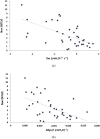Relationships between the pulmonary densitometry values obtained by CT and the forced oscillation technique parameters in patients with silicosis
- PMID: 25747897
- PMCID: PMC4628485
- DOI: 10.1259/bjr.20150028
Relationships between the pulmonary densitometry values obtained by CT and the forced oscillation technique parameters in patients with silicosis
Abstract
Objective: To evaluate the correlations between pulmonary densitometry values and forced oscillation technique (FOT) parameters in patients with silicosis.
Methods: This cross-sectional study comprised 36 non-smoker patients with silicosis and 20 matched control subjects who were submitted to FOT and multidetector CT (MDCT).
Results: Compared with the control subjects, the MDCT evaluation demonstrated that patients with silicosis exhibited greater total lung mass. These patients also had larger non-aerated and poorly aerated compartments, which included nodules and scarring. Compared with the control subjects, FOT evaluation demonstrated that patients with silicosis exhibited changes in both reactive and resistive properties of the respiratory system. In these patients, there was a greater heterogeneity of the respiratory system and increased work of breathing. Significant correlations between non-aerated compartment size and FOT parameters that reflect the non-homogeneity of the respiratory system were observed. The dynamic compliance of the respiratory system was negatively correlated with non-aerated compartment size, while the impedance at 4 Hz was positively correlated with non-aerated compartment size.
Conclusion: Patients with silicosis have heavier lungs. In these patients, a larger non-aerated compartment is associated with a worsening of lung function. A more significant pulmonary involvement is associated with a loss of homogeneity and increased mechanical load of the respiratory system. Advances in knowledge The findings provided by both pulmonary densitometry and FOT may add valuable information to the subjective analysis of silicosis; however, more studies are necessary to evaluate the potential use of these methods for assessing disease progression.
Figures



Similar articles
-
Association of respiratory integer and fractional-order models with structural abnormalities in silicosis.Comput Methods Programs Biomed. 2019 Apr;172:53-63. doi: 10.1016/j.cmpb.2019.02.003. Epub 2019 Feb 7. Comput Methods Programs Biomed. 2019. PMID: 30902127
-
The Role of Multidetector Computed Tomography and the Forced Oscillation Technique in Assessing Lung Damage in Adults With Cystic Fibrosis.Respir Care. 2018 Apr;63(4):430-440. doi: 10.4187/respcare.05815. Epub 2017 Dec 5. Respir Care. 2018. PMID: 29208759
-
Correlations between forced oscillation technique parameters and pulmonary densitovolumetry values in patients with acromegaly.Braz J Med Biol Res. 2015 Oct;48(10):877-85. doi: 10.1590/1414-431X20154786. Epub 2015 Aug 4. Braz J Med Biol Res. 2015. PMID: 26445330 Free PMC article.
-
Oscillation mechanics of the respiratory system in never-smoking patients with silicosis: pathophysiological study and evaluation of diagnostic accuracy.Clinics (Sao Paulo). 2013 May;68(5):644-51. doi: 10.6061/clinics/2013(05)11. Clinics (Sao Paulo). 2013. PMID: 23778400 Free PMC article.
-
[Respiratory mechanics in animals. 2. The forced oscillation technique--review].Berl Munch Tierarztl Wochenschr. 1997 Jul-Aug;110(7-8):257-66. Berl Munch Tierarztl Wochenschr. 1997. PMID: 9324926 Review. German.
Cited by
-
Pulmonary Densitovolumetry Using Computed Tomography in Patients with Nontuberculous Mycobacteria: Correlation with Pulmonary Function Tests.Pulm Med. 2019 Feb 3;2019:5942783. doi: 10.1155/2019/5942783. eCollection 2019. Pulm Med. 2019. PMID: 30863639 Free PMC article.
-
Machine learning associated with respiratory oscillometry: a computer-aided diagnosis system for the detection of respiratory abnormalities in systemic sclerosis.Biomed Eng Online. 2021 Mar 25;20(1):31. doi: 10.1186/s12938-021-00865-9. Biomed Eng Online. 2021. PMID: 33766046 Free PMC article.
-
Oscillometry of the respiratory system in Parkinson's disease: physiological changes and diagnostic use.BMC Pulm Med. 2023 Oct 26;23(1):406. doi: 10.1186/s12890-023-02716-w. BMC Pulm Med. 2023. PMID: 37884922 Free PMC article.
-
Respiratory oscillometry and functional analyses in patients with idiopathic scoliosis.Braz J Med Biol Res. 2023 Nov 3;56:e12898. doi: 10.1590/1414-431X2023e12898. eCollection 2023. Braz J Med Biol Res. 2023. PMID: 37937601 Free PMC article.
-
Clinical significance and applications of oscillometry.Eur Respir Rev. 2022 Feb 9;31(163):210208. doi: 10.1183/16000617.0208-2021. Print 2022 Mar 31. Eur Respir Rev. 2022. PMID: 35140105 Free PMC article. Review.
References
-
- Wagner GR. Asbestosis and silicosis. Lancet 1997; 349: 1311–15. - PubMed
-
- Lopes AJ, Costa W, Thomaz Mafort T, de Sá Ferreira A, Silveira de Menezes SL, Silva Guimarães F. Silicosis in sandblasters of shipyard versus silicosis in stone carvers in Brazil: a comparison of imaging findings, lung function variables and cardiopulmonary exercise testing parameters. [In English, Portuguese.] Rev Port Pneumol 2012; 18: 260–6. doi: 10.1016/j.rppneu.2012.04.006 - DOI - PubMed
-
- Ferreira AS, Moreira VB, Ricardo HM, Coutinho R, Gabetto JM, Marchiori E. Progressive massive fibrosis in silica-exposed workers. High-resolution computed tomography findings. [In English, Portuguese.] J Bras Pneumol 2006; 32: 523–8. - PubMed
Publication types
MeSH terms
LinkOut - more resources
Full Text Sources
Other Literature Sources

